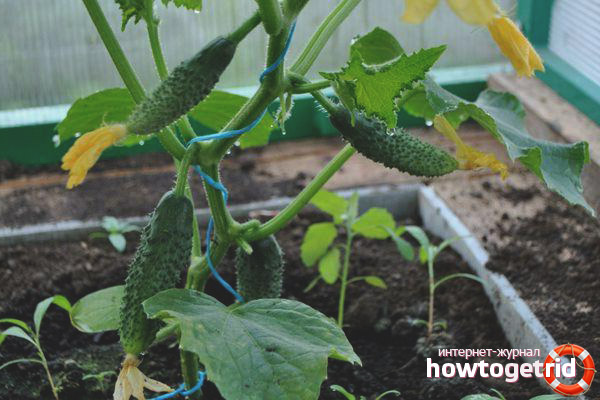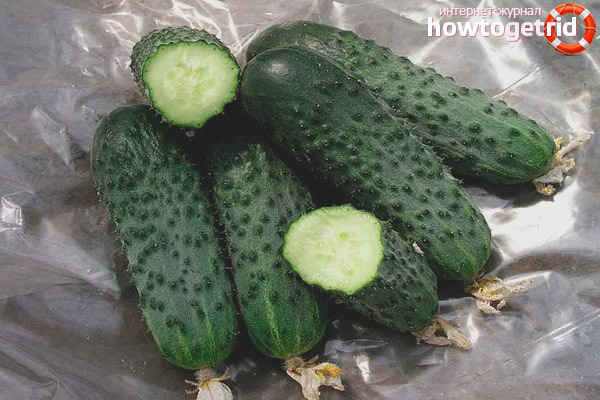The content of the article
Even a novice can handle the cultivation of cucumbers. Vegetable culture requires simple rules for care. Satin variety is characterized by high productivity and unpretentiousness to weather conditions.
The main advantage of the hybrid variety is the bright green color of the fruits and excellent taste characteristics. The plant is pollinated independently, intended for cultivation on open ground, but can be grown in closed greenhouses.
Grade description
The satin variety has early ripening. It is characterized by good resistance to temperature changes. It is preferable to grow cucumbers on high beds. Fruiting begins 35-40 days after the appearance of the first sprouts. Bushes are medium-braided, female flowering. The ovaries are formed by bundles, in each 6-8 fruits are formed. In height, the bushes do not exceed 1.5 meters. Leaves are dark green, medium size, wavy edges. 3.8 to 4.5 kg of ripe cucumbers are removed from one square meter.
The shape of the fruit is oval, in the form of a cylinder. The skin is dark green, the presence of large tubercles and dense pubescence is noted on the surface. Also on the fruits there are white spikes and light short stripes. The mass of one cucumber varies between 80-110 grams, short in length. The fruits are almost the same in size, ripening occurs together, which is very convenient for pickling or pickling. The pulp is tasty, juicy and crispy. There is no bitter taste.
The satin variety of cucumbers is universal. The fruits are consumed raw, made from them slices and salads, and also used to roll cans for the winter.
Cultivation agricultural
Hybrid requires fertile soil, regular watering, cultivation. Planting cucumbers is best after cabbage, onions, potatoes and peppers.
In order for the seed material to be more resistant to diseases and the influence of harmful insects, it must undergo pre-treatment. Seeds are kept in a solution of potassium permanganate. In a glass of water, 1 gram of manganese potassium is diluted, and the seeds are placed there for 20 minutes. After disinfection, sowing is performed. The soil should also be shed with an identical solution. 5 grams of potassium permanganate are diluted in a bucket of water, and the soil is shed. Land must be dug up, weeds destroyed.
Planting seeds
Cucumbers are planted in rows, observing the distance between neighboring plants. In the greenhouses between the bushes leave a space of about 15 cm, the row spacing is about 60 cm. On open beds and between plants and between rows, 60 cm of free space should be left. For the convenience of harvesting and caring events, plant lashes are tied to a trellis.
Before planting, the soil must be fertilized with organic and mineral additives. The soil should be well-heated, the optimum temperature is + 25- + 27 degrees. Seeds deepen no more than 3 cm. Otherwise, the sprouts may simply not get out of the ground. As soon as 5 full leaves appear on the sprouts, they are tied to the trellis. To obtain a richer crop, plants are formed into 1 stalk. Side shoots are removed.
Care Features

Bushes need timely regular watering. The procedure should be 4-6 times per week. It is necessary to water only with warm, settled water in the evening or in the morning until sunrise.Avoid getting water on the shoots and leaves of plants. For cucumbers, it is preferable to choose a drip irrigation method. This will evenly distribute moisture.
For feeding nutritional compositions containing nitrogen, potassium and phosphorus are used. During flowering and during fruiting, this will be an indispensable procedure. Plants in this period need additional nutrition.
After watering, it is advisable to loosen the soil. This should be done with caution so as not to damage the roots of the bushes. Loosening will help saturate the root system with oxygen. Along with loosening and hilling, weed must be disposed of in a timely manner. Weeds interfere with the full development of cucumbers, take nutrients from the soil, and carry dangerous viruses.
Disease and pests
Although the satin variety has a strong immunity to various diseases and pests, but due to improper care, it can be damaged. For prevention, the bushes are treated with various insecticidal agents, folk remedies. A good way to scare away pests is to have a lot of smelling plants such as garlic, onions or dill.
The most common diseases to which cucumbers can be exposed:
- Olive spotting. The fungus infects the fruit. A sign is the appearance of ulcers, dark red in color on the surface of the skin of the cucumber. May occur with increased soil moisture.
- Mosaic virus. It affects not only the fruits, but also the foliage. It is expressed in the appearance of spots of yellow and white.
- Bacteriosis. May affect plant leaves in high humidity. White spots appear on the leaves of plants.
In order to prevent infection with fungi, you must follow the rules for care and arrange the appropriate conditions for the plants for full growth and development. Only in this case, the satin variety will delight you with its high yield and healthy fruits.
The satin variety of cucumbers has excellent taste, unpretentiousness to climatic conditions and undemanding. It is important to follow the basic rules for care, and you will get an excellent result. Reviews of experienced growers about the variety are only positive.
Video: Satin F1 cucumbers










Submit